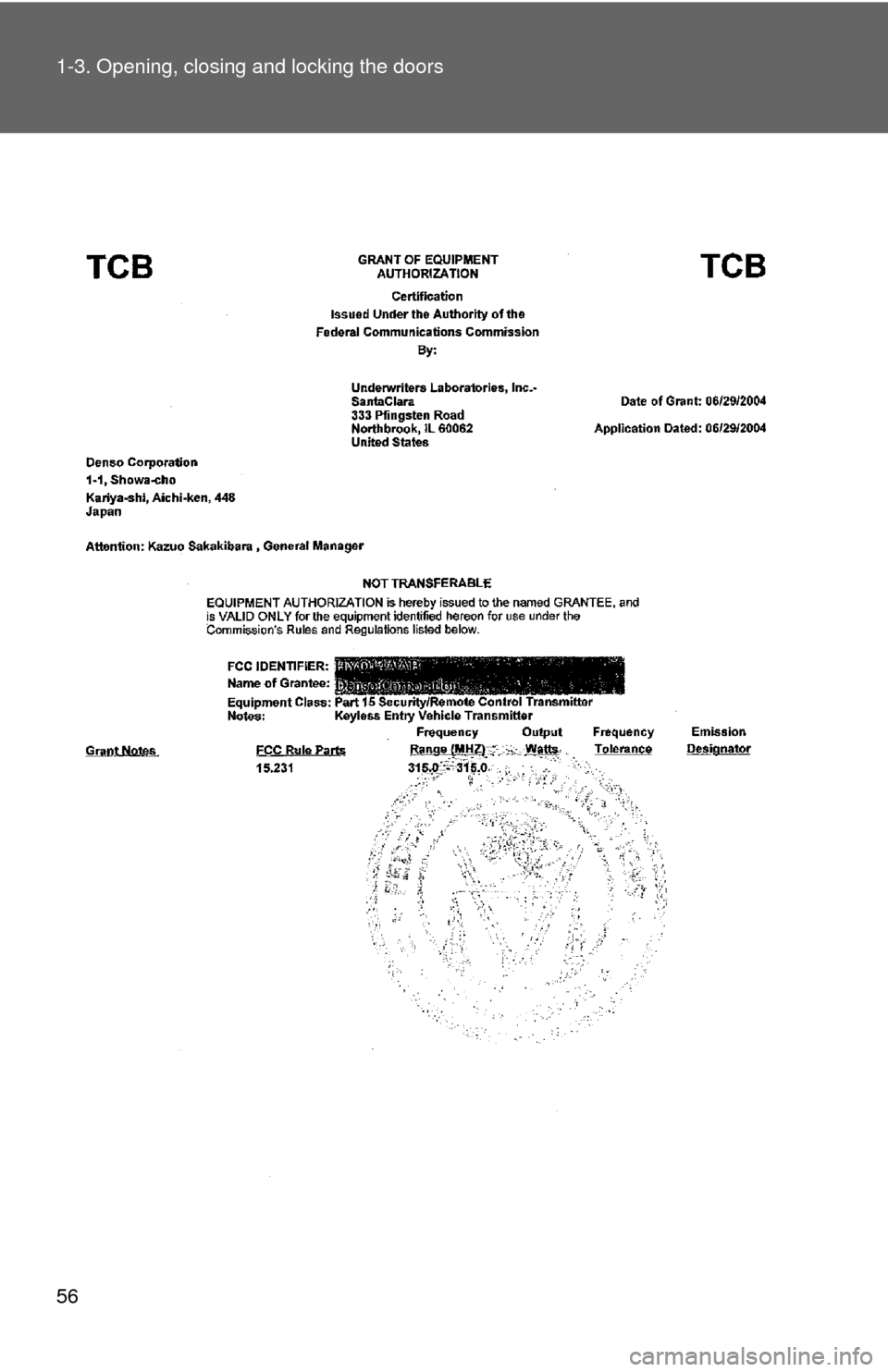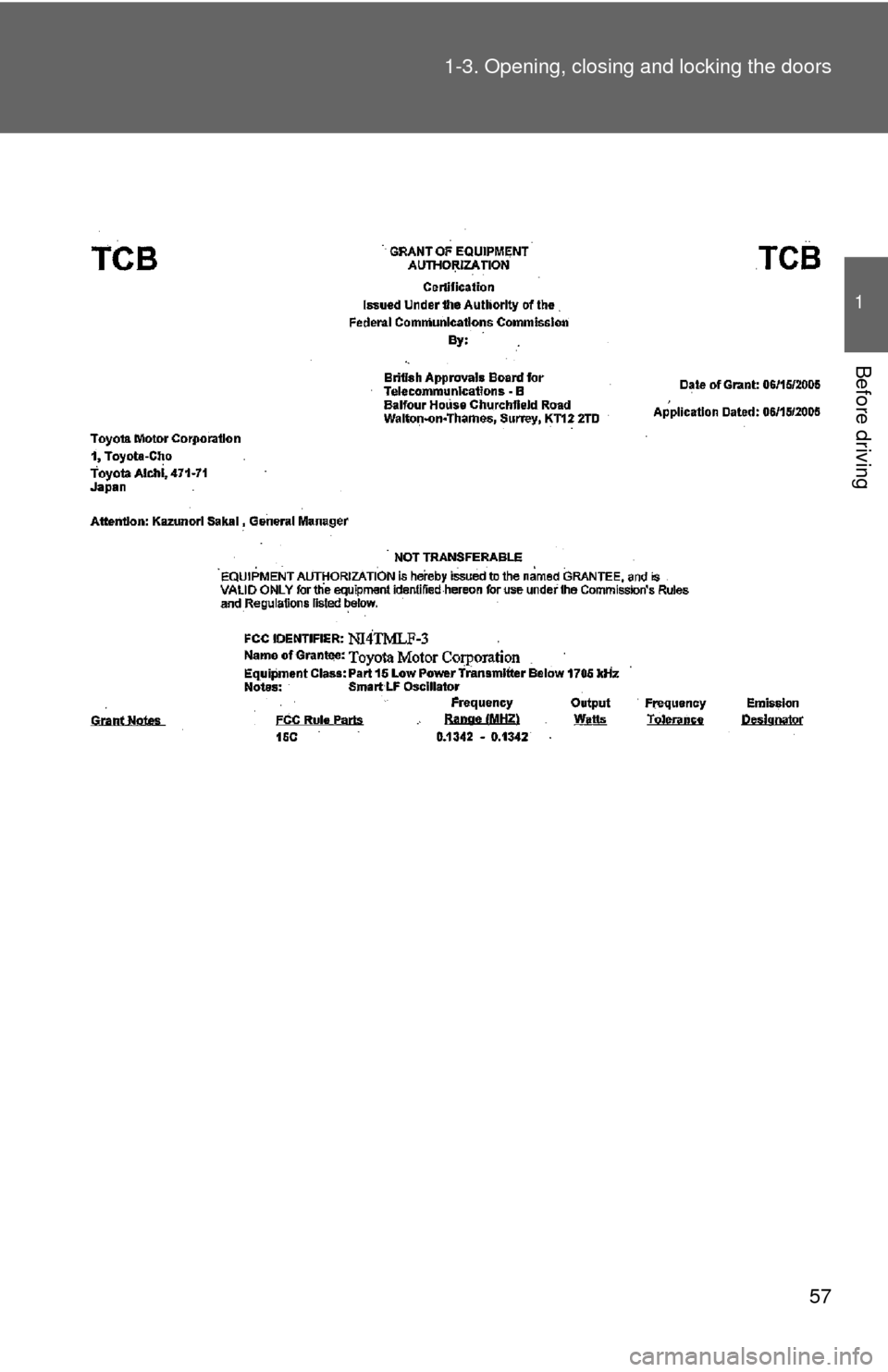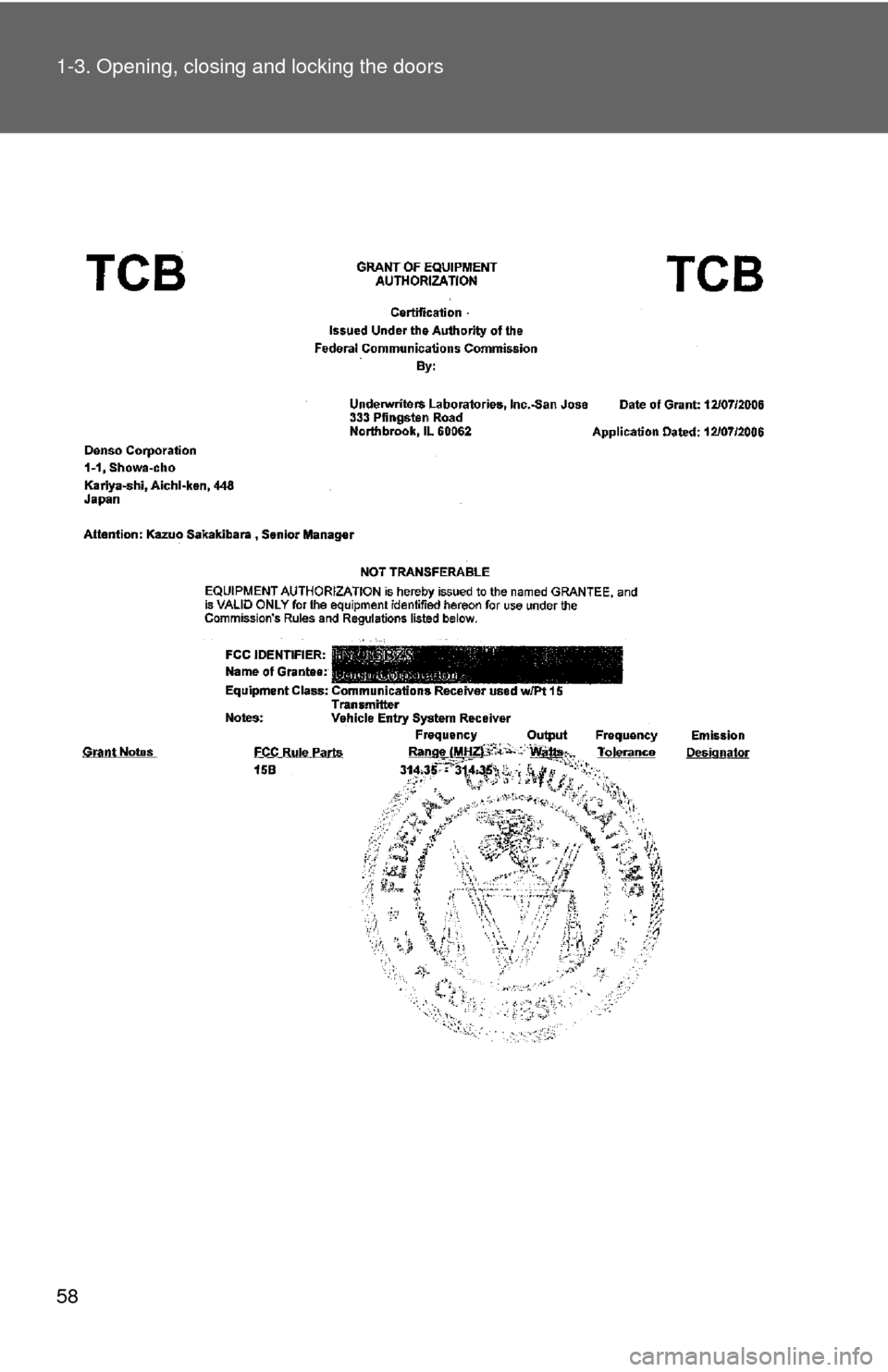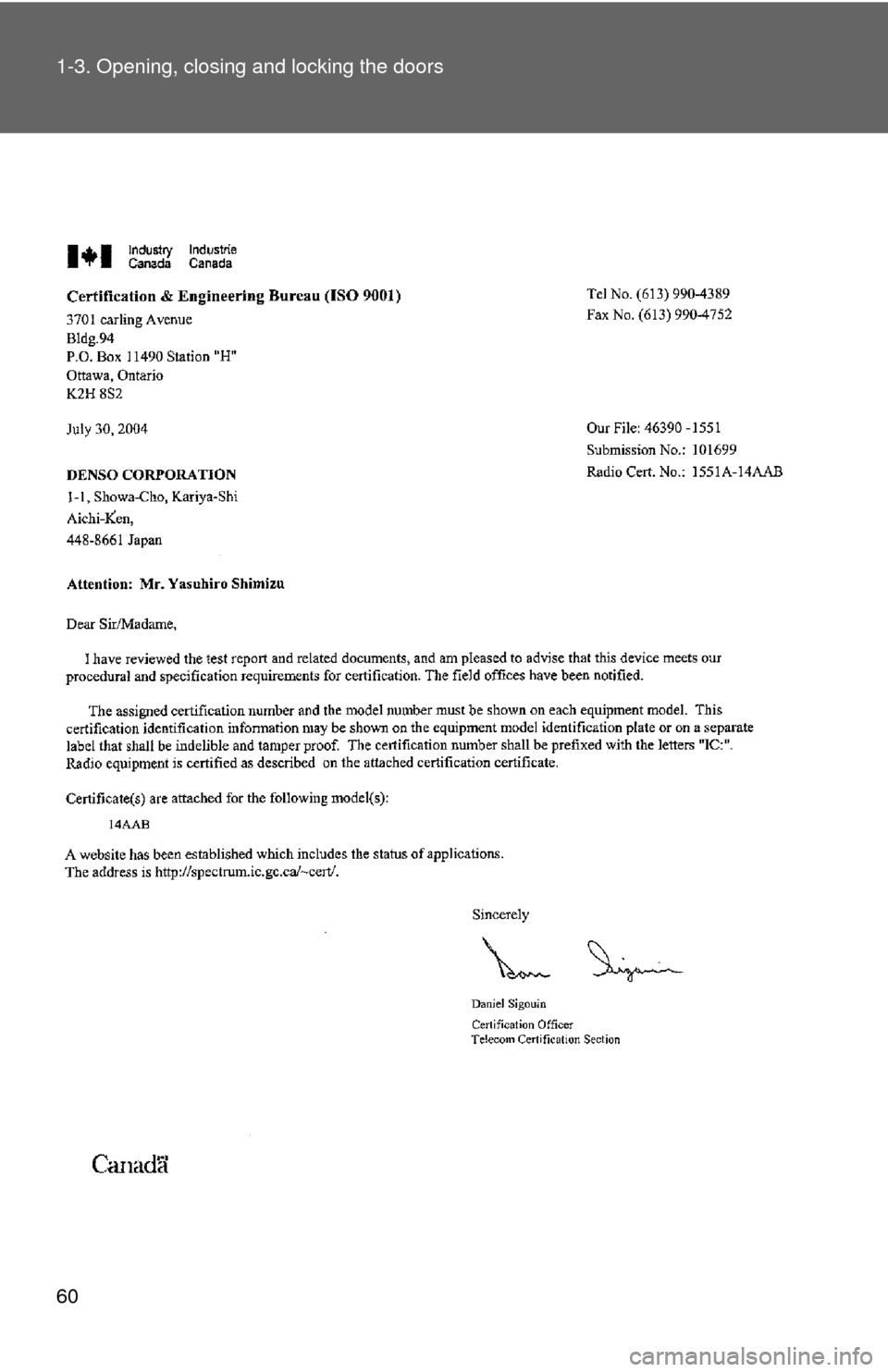TOYOTA HIGHLANDER HYBRID 2010 XU40 / 2.G Workshop Manual
Manufacturer: TOYOTA, Model Year: 2010, Model line: HIGHLANDER HYBRID, Model: TOYOTA HIGHLANDER HYBRID 2010 XU40 / 2.GPages: 592, PDF Size: 12 MB
Page 51 of 592

51
1-3. Opening, closing and locking the doors
1
Before driving
■
Electronic key battery depletion
●The standard battery life is 1 to 2 years. (The battery becomes depleted
even if the electronic key is not used.) If the smart key system or the
wireless remote control function does not operate, or the detection area
becomes smaller, the battery may be depleted. Replace the battery when
necessary. ( P. 465)
● To avoid serious deterioration, do not leave the electronic key within 3 ft.
(1 m) of the following electrical appliances that produce a magnetic field.
•TVs
• Personal computers
• Recharging cellular phones or cordless phones
• Table lamps
■ To operate the system properly
Make sure to carry the electronic key when operating the system. Do not get
the electronic key too close to the vehicle when operating the system from
the outside of the vehicle.
Depending on the position and holding condition of the electronic key, the
key may not be detected correctly and the system may not operate properly.
(The alarm may go off accidentally, or the door lock prevention may not func-
tion.)
■ Note for the entry function
●Even when the electronic key is within the effective range (detection
areas), the system may not operate properly in the following cases.
• The electronic key is too close to the window or outside door handle,
near the ground, or in a high place when the doors are locked or
unlocked.
• The electronic key is on the instrument panel, luggage cover, floor or in the glove box when the hybrid system is started or “POWER” switch
modes are changed.
● As long as the electronic key is within the effective range, the doors may
be locked or unlocked by anyone.
● Even if the electronic key is not inside the vehicle, it may be possible to
start the hybrid system if the electronic key is near the window.
Page 52 of 592

52 1-3. Opening, closing and locking the doors
●The doors may unlock if a large amount of water splashes on the door
handle, such as in the rain or in a car wash. (The doors will automatically
be locked after approximately 60 seconds if the doors are not opened
and closed.)
● Gripping the door handle when wearing a glove may not unlock the door.
● If the wireless remote control is used to lock the doors when the elec-
tronic key is near the vehicle, there is a possibility that the door may not
be unlocked by the entry function. (Use the wireless remote control to
unlock the doors.)
■ When the vehicle is not driven for extended periods
To prevent theft of the vehicle, do not leave the electronic key within 6 ft. (2
m) of the vehicle.
■ Security feature
If a door is not opened within approximately 60 seconds after the vehicle is
unlocked, the security feature automatically locks the vehicle again.
■ Alarms and warning indicators
A combination of exterior and interior alarms as well as warning lights and
warning messages shown on the multi-information display are used to
reduce the chance of vehicle theft and accidents resulting from erroneous
operation.
●When any warning lights come on:
Take appropriate measures according to which warning light comes on.
( P. 502)
● When a warning message is shown on the multi-information display:
Take appropriate measures according to the warning message on the
multi-information display. ( P. 511)
Page 53 of 592

53
1-3. Opening, closing and locking the doors
1
Before driving
●
When an alarm sounds:
Take appropriate measures according to the following table.
AlarmSituationCorrection procedure
Exterior alarm
sounds once for
2 seconds Tried to lock the doors and
the glass hatch using the
entry function while the
electronic key is still inside
the passenger compart-
ment.
Retrieve the elec-
tronic key from the
passenger compart-
ment and lock the
doors and the glass
hatch again.
Tried to close the glass
hatch with the electronic
key inside and all doors
were locked. Retrieve the elec-
tronic key and close
the glass hatch.
Tried to exit the vehicle
with the electronic key and
lock the doors without first
turning the “POWER”
switch OFF. Turn the “POWER”
switch OFF and lock
the doors again.
Exterior alarm
sounds once for
10 seconds Tried to lock the vehicle
using the entry function
while a door is open. Close all of the doors
and lock the doors
again.
Interior alarm
sounds continu-
ously Tried to open the door and
exit the vehicle without
shifting the shift lever to P.
Shift the shift lever to
P.
Interior alarm
beeps repeatedly Turned the “POWER”
switch to ACCESSORY
mode while the driver's
door is open. (Opened the
driver's door when the
“POWER” switch is in
ACCESSORY mode.)
Turn the “POWER”
switch OFF and close
the driver's door.
Turned the “POWER”
switch OFF while the
driver's door is open. Close the driver's
door.
Page 54 of 592

54 1-3. Opening, closing and locking the doors
*: A message will be shown on the multi-information display.
■ If the smart key system does not operate properly
● Locking and unlocking the doors: Use the mechanical key. ( P. 528)
● Starting the hybrid system. ( P. 528)
■ When the electronic key battery is fully depleted
P. 465
AlarmSituationCorrection procedure
Interior and exte-
rior alarms sound
continuously.* Tried to close the driver’s
door after carrying the key
outside the vehicle with the
“POWER” switch in ON or
ACCESSORY mode and
without the shift lever
being in P. Shift the shift lever to
P, turn the “POWER”
switch OFF and close
the driver’s door
again.
Interior alarm
beeps once.* The electronic key has a
low battery.
Replace the electronic
key battery.
Tried to start the hybrid
system without the elec-
tronic key being present,
or when the electronic key
was not functioning nor-
mally. Start the hybrid sys-
tem with the elec-
tronic key present.
Interior alarm
beeps once and
exterior alarm
sounds 3 times.* Tried to close the driver’s
door after carrying the key
outside the vehicle without
turning the “POWER”
switch OFF.
Turn the “POWER”
switch OFF and close
the driver’s door
again.
An occupant carried the
electronic key outside the
vehicle and closed the
door when the “POWER”
switch was in ON or
ACCESSORY mode. Bring the electronic
key back into the vehi-
cle.
Page 55 of 592

55
1-3. Opening, closing and locking the doors
1
Before driving
■
Customization that can be co nfigured at Toyota dealer
It is possible to deactivate the smart key system etc.
(Customizable features P. 569)
■ Certification for the smart key system
For vehicles sold in the U.S.A.
NOTE:
This device complies with Part 15 of the FCC Rules. Operation is subject to
the following two conditions: (1) This device may not cause harmful interfer-
ence, and (2) this device must accept any interference received, including
interference that may cause undesired operation.
NOTICE:
This equipment has been tested and found to comply with the limits for a
Class B digital device, pursuant to Part 15 of the FCC Rules. These limits
are designed to provide reasonable protection against harmful interference
in a residential installation. This equipment generates, uses and can radiate
radio frequency energy and, if not installed and used in accordance with the
instructions, may cause harmful interference to radio communications. How-
ever, there is no guarantee that interference will not occur in a particular
installation. If this equipment does cause harmful interference to radio or
television reception, which can be determined by turning the equipment off
and on, the user is encouraged to try to correct the interference by one or
more of the following measures:
● Reorient or relocate the receiving antenna.
● Increase the separation between the equipment and receiver.
● Connect the equipment into an outlet on a circuit different from that to
which the receiver is connected.
● Consult the dealer or an experienced radio/TV technician for help.
FCC WARNING:
Changes or modifications not expressly approved by the party responsible
for compliance could void the user's authority to operate the equipment.
FCC ID: NI4TMLF-2
FCC ID: NI4TMLF-3
Page 56 of 592

56 1-3. Opening, closing and locking the doors
Page 57 of 592

57
1-3. Opening, closing and locking the doors
1
Before driving
Page 58 of 592

58 1-3. Opening, closing and locking the doors
Page 59 of 592

59
1-3. Opening, closing and locking the doors
1
Before driving
For vehicles sold in Canada
NOTE:
Operation is subject to the following two conditions: (1) this device may not
cause interference, and (2) this device must accept any interference, includ-
ing interference that may cause undesired operation of the device.
Page 60 of 592

60 1-3. Opening, closing and locking the doors